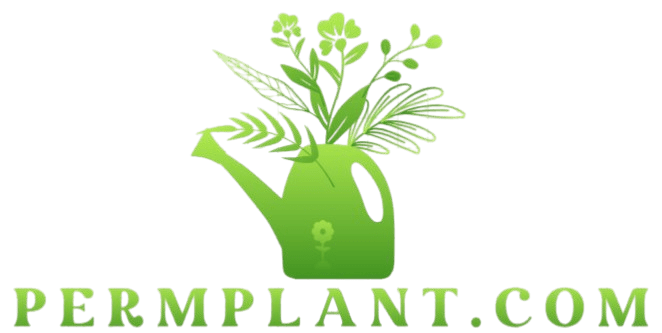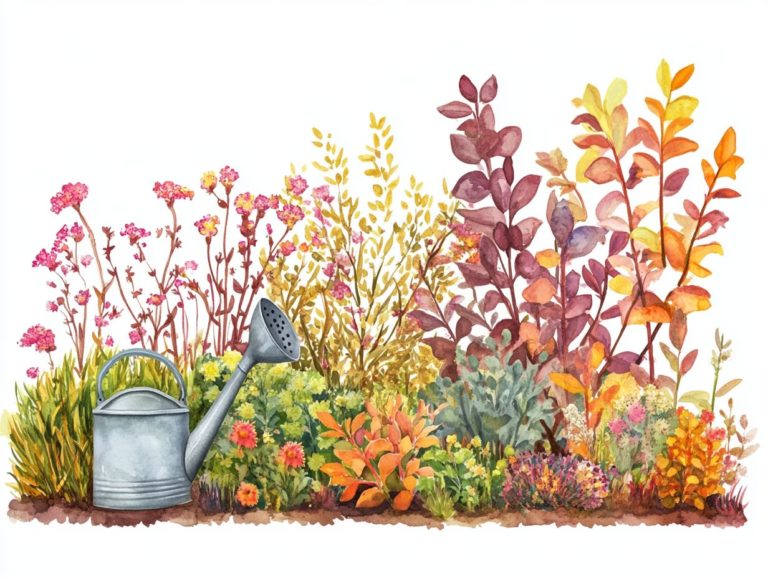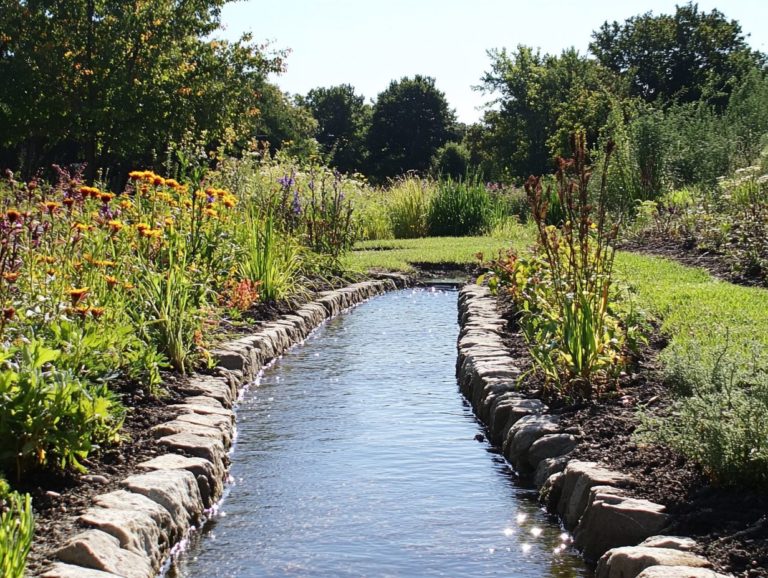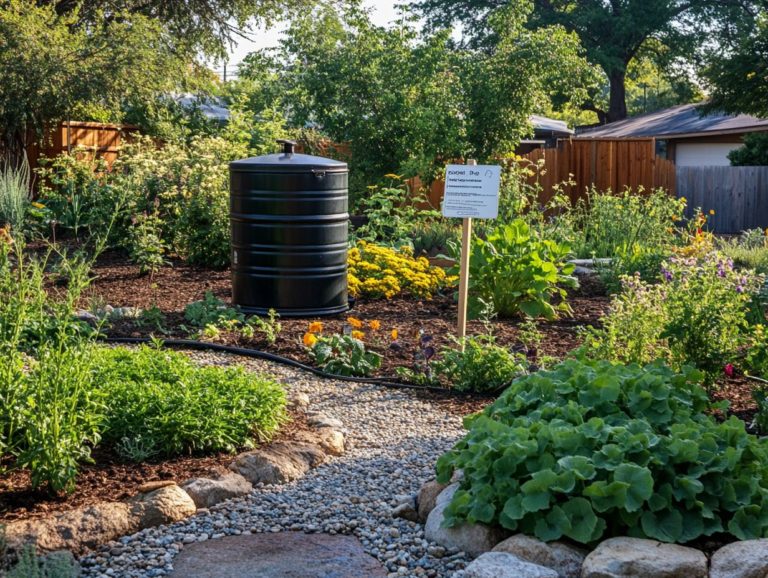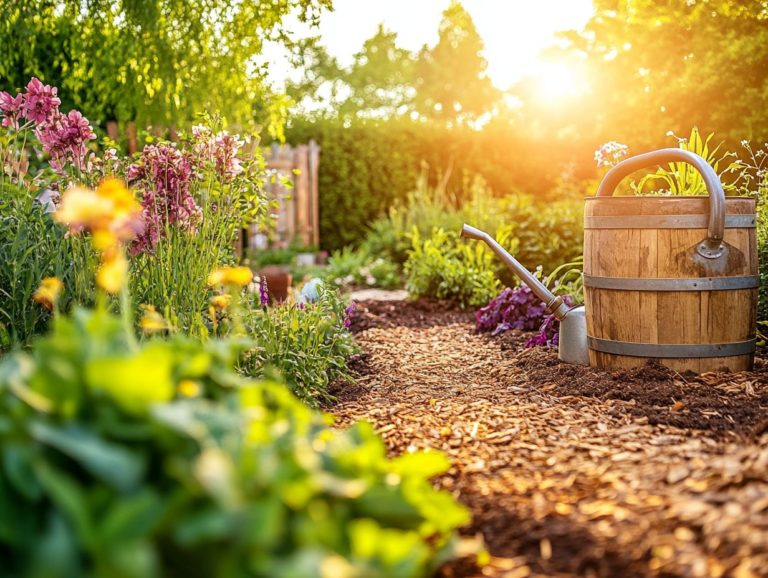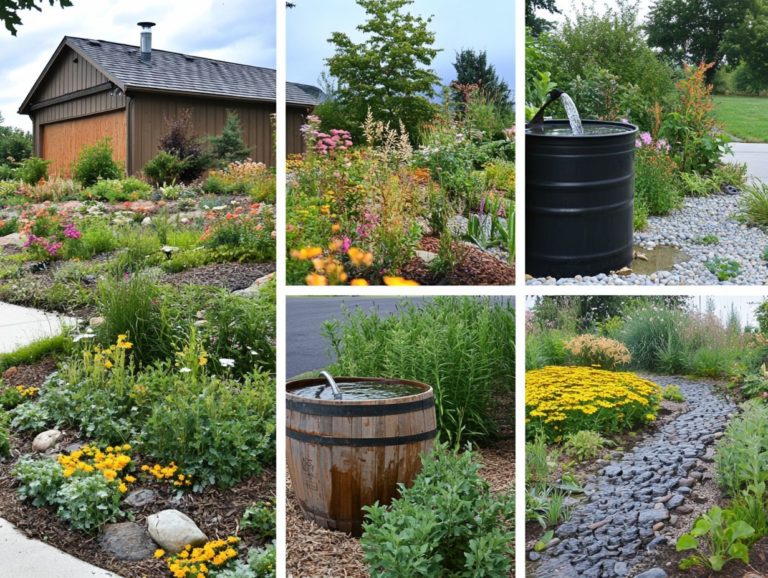How to Manage Water in Urban Permaculture
Join us as we explore urban permaculture! Discover how you can create vibrant, sustainable spaces right in your city.
Urban permaculture presents a wealth of innovative solutions for sustainable living in bustling urban environments. Effective water management is essential for its success.
As you navigate the challenges of limited resources and environmental pressures in urban spaces, understanding and implementing efficient water strategies becomes crucial.
This article delves into urban permaculture, highlighting its unique obstacles and showcasing practical techniques such as rainwater harvesting and greywater recycling (water from sinks and showers that can be reused).
Discover how these methods elevate sustainability and significantly enhance urban ecosystems.
Contents
- Key Takeaways:
- Understanding Water Management in Urban Permaculture
- Challenges of Water Management in Urban Areas
- Strategies for Managing Water in Urban Permaculture
- Implementing Water Management Techniques
- Benefits of Water Management in Urban Permaculture
- Frequently Asked Questions
- What is urban permaculture?
- Why is managing water important in urban permaculture?
- What are some ways to manage water in urban permaculture?
- How can rainwater harvesting be implemented in urban permaculture?
- What is greywater recycling and how is it used in urban permaculture?
- What are some benefits of managing water in urban permaculture?
Key Takeaways:
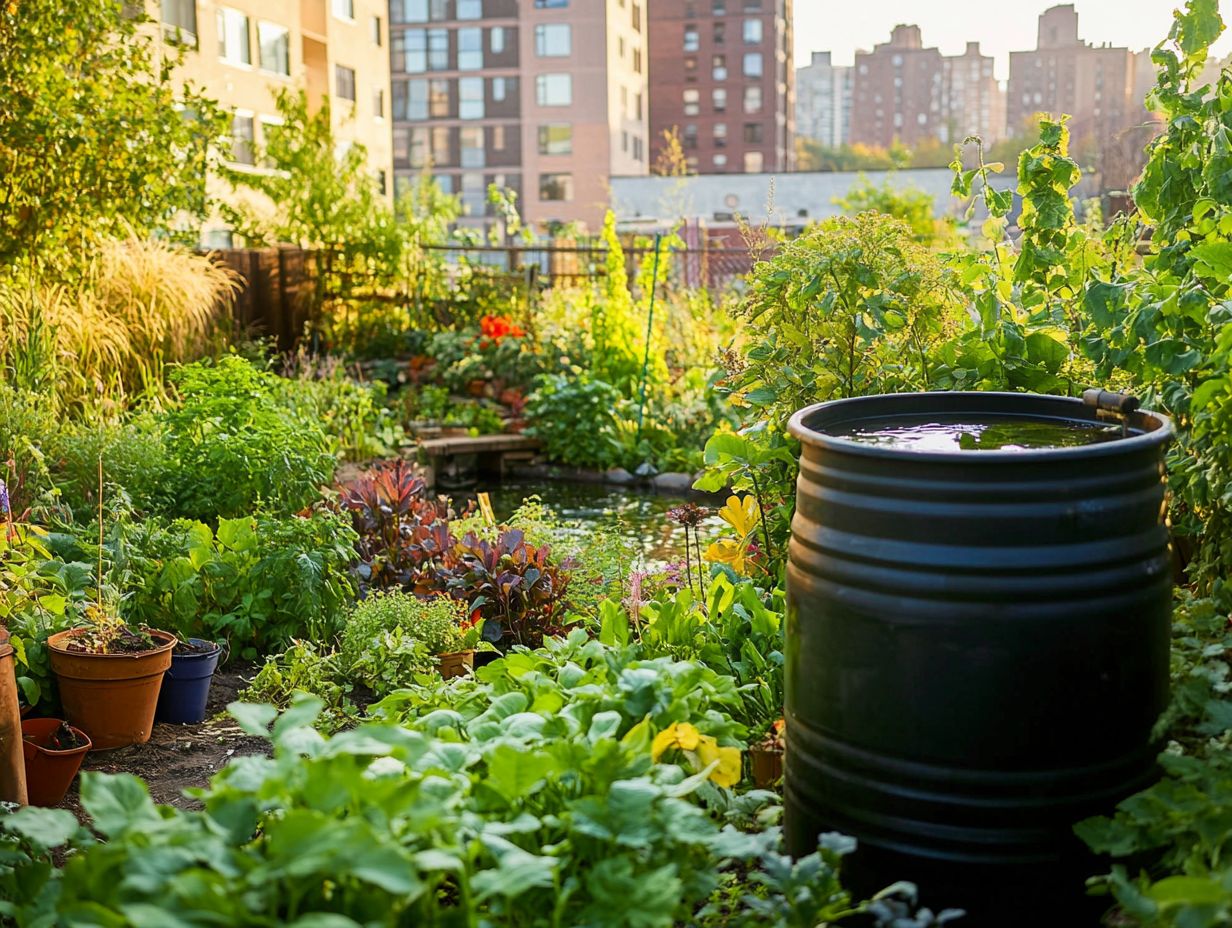
- Make the most of your space and resources by implementing rainwater harvesting and greywater recycling techniques in urban permaculture, reinforcing the importance of water conservation.
- Address environmental challenges by understanding and managing water usage in urban areas, promoting sustainable living, and reducing environmental impact.
- Follow a step-by-step process to effectively implement water management techniques in urban permaculture for a more resilient and self-sufficient ecosystem.
Understanding Water Management in Urban Permaculture
Water management in urban permaculture is vital. It helps create sustainable food systems that respect nature, engage communities, and tackle global water issues through strategies for water conservation.
By incorporating conservation techniques like rainwater harvesting and greywater recycling, you can significantly boost groundwater supplies while addressing pressing global water challenges and issues of water access and resource scarcity.
This strategy optimizes water use and enhances ecosystem resilience while promoting water-sensitive urban design as part of a comprehensive framework for sustainable living in urban settings.
What is Urban Permaculture?
Urban permaculture blends nature-friendly ideas into city life. It creates sustainable food systems and strengthens community ties through local projects.
This innovative approach, rooted in the work of visionaries like Bill Mollison and David Holmgren, arose from the pressing need to combat environmental degradation and food insecurity in our crowded cities. By embracing techniques that mimic the rhythms of natural ecosystems, urban permaculture encourages biodiversity, fosters self-sufficient gardens, and builds resilience within local communities.
At its core, principles such as observing natural patterns, valuing diversity, and optimizing resources become tools for addressing urban challenges like heat islands and waste management. Through practical techniques like vertical gardening, composting, and water catchment systems, you cultivate nourishing food and nurture connections among residents, transforming city landscapes into thriving, sustainable habitats.
Challenges of Water Management in Urban Areas
Urban water management faces major challenges. Resource scarcity, pollution, and soil quality decline require fresh solutions.
These issues demand innovative strategies to effectively tackle the pressing environmental concerns at hand.
Limited Space and Resources
The limited space in urban environments presents significant challenges for effective water management, particularly in urban farming, where resource scarcity is a pressing concern. The unique characteristics of city landscapes often dominated by concrete and asphalt exacerbate these issues, restricting traditional agricultural methods and causing inefficient water runoff.
As urban areas continue to expand, the urgency for innovative solutions becomes clear. Vertical gardening has emerged as a creative strategy, enabling you to cultivate crops in small areas while optimizing water usage with systems designed to recycle and conserve this vital resource.
Community initiatives like neighborhood gardens not only foster collaboration among residents but also offer educational opportunities. These projects inform you about sustainable practices and highlight the importance of efficient water management in enhancing urban food security.
Environmental Factors
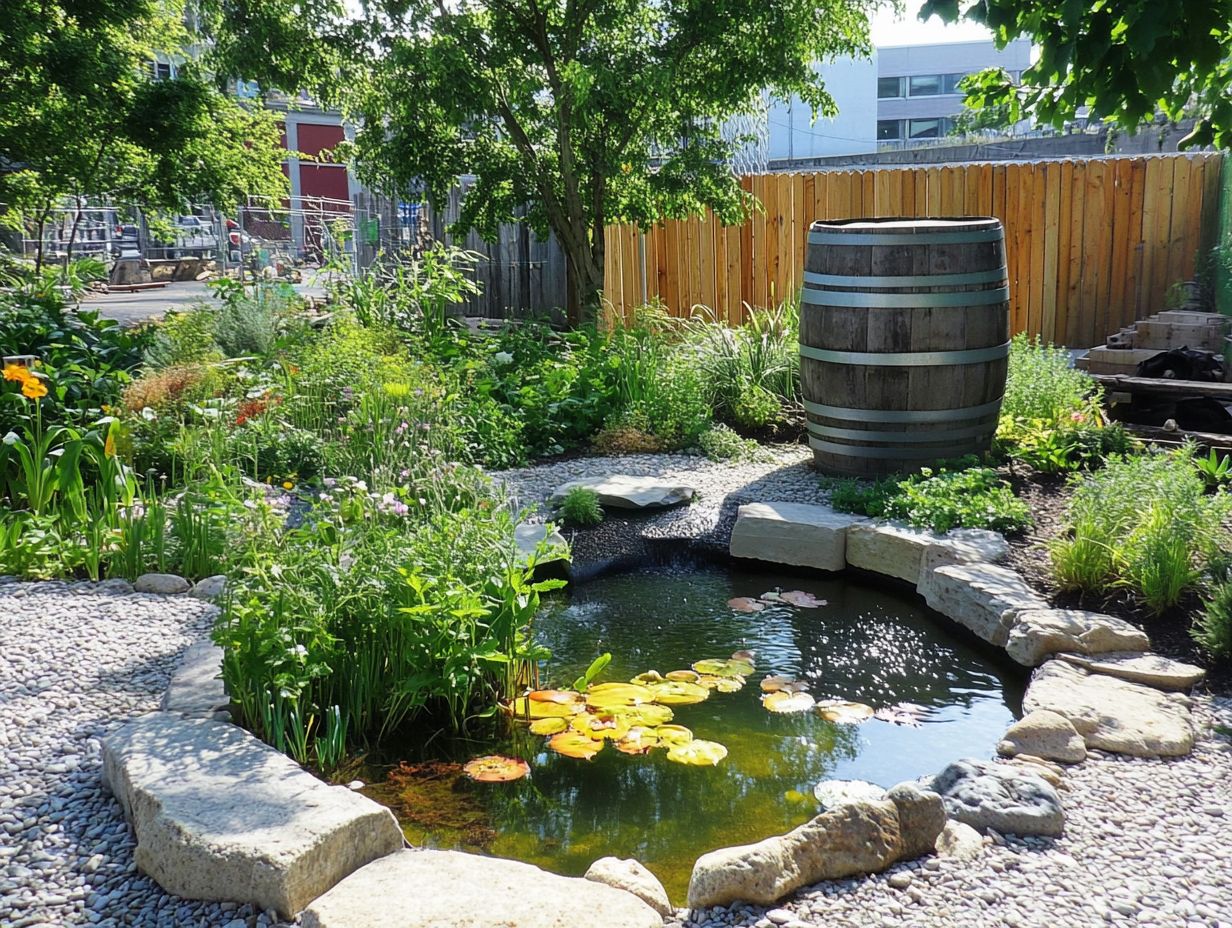
Environmental factors like climate conditions and pollution have a profound impact on your water resources and management strategies in urban areas. They directly influence both ecosystem health and the vitality of urban streams.
These challenges require you, as an urban planner or part of an environmental agency, to adapt your strategies in response to changing precipitation patterns, rising temperatures, and fluctuating pollution levels. For example, when rainfall intensity increases, it can generate more runoff, overwhelming drainage systems and leading to flooding. Conversely, prolonged droughts can deplete water supplies and demand innovative conservation techniques.
Pollution control is equally vital; contaminants from industrial runoff and urban waste can degrade water quality and threaten aquatic life. Thus, a comprehensive approach that considers all these environmental factors is essential for achieving sustainable water management in urban settings.
Strategies for Managing Water in Urban Permaculture
Implementing effective strategies for managing water in urban permaculture involves techniques such as rainwater harvesting and greywater recycling. These methods not only optimize your water resources but also foster sustainable living within urban settings.
Embracing these practices can significantly enhance your environmental impact, creating a more resilient and efficient urban ecosystem.
Rainwater Harvesting
Rainwater harvesting is a sustainable practice that allows you to collect and store rainwater for various purposes. It significantly enriches your water resources and fosters ecological balance in urban environments.
This approach dramatically lessens your dependence on traditional water supply systems and reduces stormwater runoff, which can lead to troubling urban flooding and pollution. By incorporating rainwater harvesting systems into urban permaculture practices, you can help create resilient ecosystems that support biodiversity.
These systems can vary from simple rain barrels to more sophisticated underground storage solutions, offering an eco-friendly irrigation source for your gardens and landscapes.
Embracing such techniques cultivates a culture of conservation, encouraging you and your community to be more mindful of water usage while contributing to a healthier urban environment.
Greywater Recycling
Greywater recycling is an essential aspect of effective water management. It enables you to repurpose wastewater from baths, sinks, and washing machines for irrigation and other non-potable uses.
This innovative approach not only eases the strain on freshwater resources but also fosters sustainable living, particularly within urban permaculture systems. By incorporating greywater recycling into your landscape design, you can create a closed-loop system that nourishes your plants while minimizing reliance on chemical fertilizers.
Moreover, this practice plays a significant role in conservation efforts, helping cities manage stormwater efficiently and reduce runoff. Ultimately, embracing greywater solutions not only supports local ecosystems but also empowers you and your community to engage actively in sustainable resource management, paving the way for a resilient future in urban landscapes.
Join your neighbors in implementing these solutions for a greener community!
Implementing Water Management Techniques
Implementing effective water management techniques in urban permaculture (sustainable farming that mimics natural ecosystems) necessitates careful planning and active community involvement. Understanding the principles of water management in design makes irrigation systems and conservation efforts sustainable, creating a resilient and thriving environment for all!
Step-by-Step Process
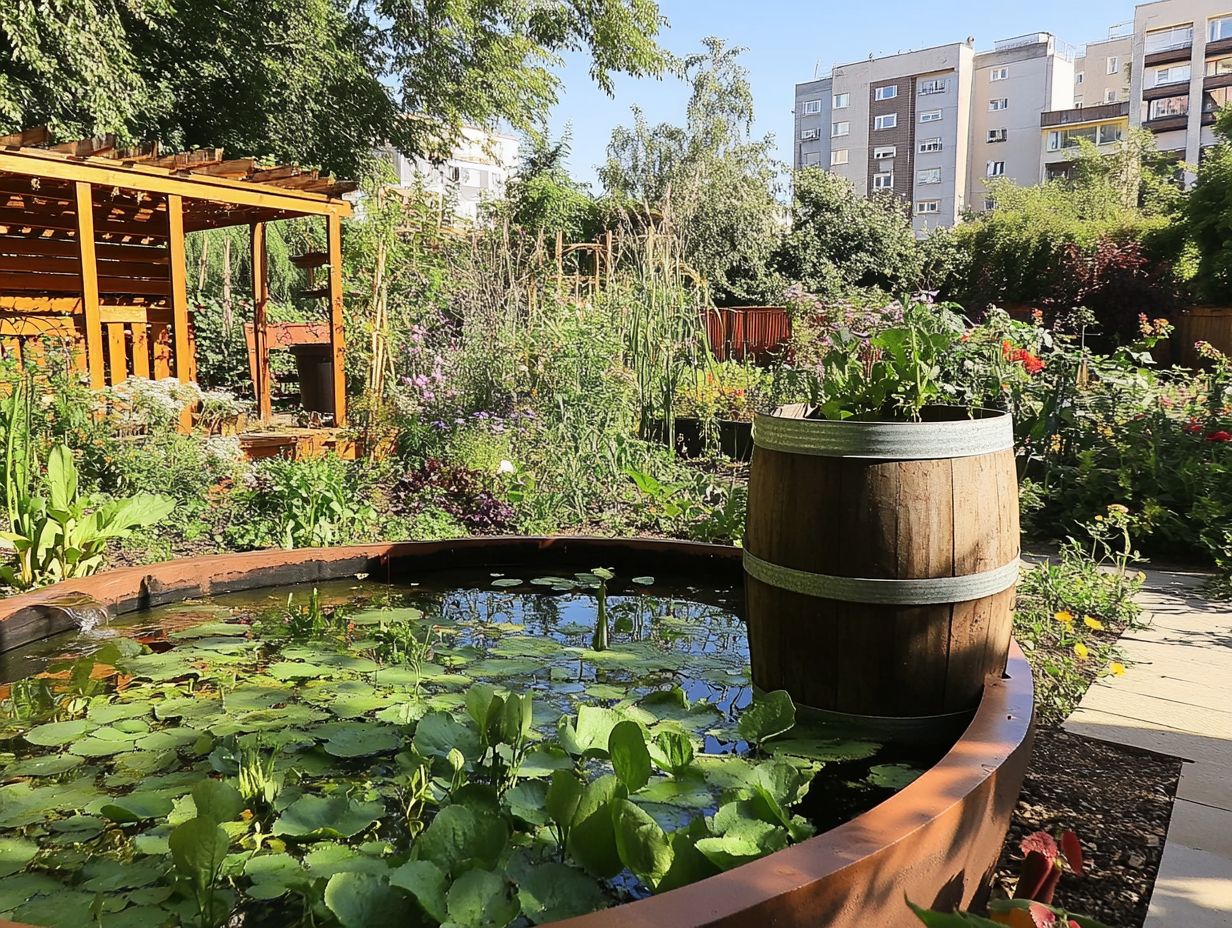
The step-by-step process for implementing effective water management in urban permaculture starts with assessing local resources, including water resources and groundwater. Next, you can refer to the principles of water management in design to design appropriate systems and engage the community for support and participation.
-
Start by evaluating your available water sources! Think rainwater, groundwater, and municipal supplies while paying close attention to their quality and quantity.
-
Once you’ve gathered this information, move on to designing an integrated water system. This might involve techniques such as rain gardens, swales, and drip irrigation, along with learning how to use greywater in permaculture, all customized to meet the unique needs of your urban environment.
Next, community engagement becomes essential. Organizing workshops and informational sessions allows you to educate residents about sustainable practices and inspire their involvement. By fostering collaboration, you empower residents to contribute to these initiatives and take on the role of stewards for the developed water systems.
Benefits of Water Management in Urban Permaculture
The advantages of effective water management in urban permaculture transcend mere individual practices. It plays a pivotal role in fostering sustainable living, enhancing ecosystem resilience, and restoring biodiversity. Understanding the importance of water in permaculture systems all contribute to healthier urban environments.
By embracing these principles, you re not just improving your immediate surroundings; you re also nurturing a thriving, interconnected ecosystem.
Sustainable Living and Environmental Impact
Sustainable living practices rooted in effective water management can profoundly impact the environment, enhancing community resilience and contributing to the ecological balance of urban ecosystems.
Embracing sustainable landscaping techniques, such as xeriscaping, minimizes your need for irrigation. This approach demonstrates how thoughtful water use directly correlates with a reduced environmental footprint, ultimately fostering healthier urban habitats.
By implementing rainwater harvesting systems, you can significantly reduce your dependency on municipal water supplies, leading to a more efficient use of local resources. Take a cue from cities like Melbourne, which have successfully integrated stormwater management strategies. These strategies not only prevent flooding but also boost local biodiversity! They ensure that stormwater is captured and reused, creating a mutually beneficial scenario for residents and surrounding wildlife.
Frequently Asked Questions
What is urban permaculture?
Urban permaculture is a sustainable gardening and living practice designed to mimic natural ecosystems in an urban environment, utilizing resources efficiently and promoting self-sufficiency.
Why is managing water important in urban permaculture?

Water is a valuable resource in urban areas and is often scarce. With careful management and understanding of how to water your permaculture garden efficiently, water can be conserved and used effectively to support a thriving permaculture system.
What are some ways to manage water in urban permaculture?
Some methods for managing water in urban permaculture include rainwater harvesting, greywater recycling (water from sinks, showers, and washing machines that can be reused), and understanding the water cycle in permaculture by using drought-tolerant plants and water-efficient irrigation systems.
How can rainwater harvesting be implemented in urban permaculture?
Rainwater harvesting involves collecting and storing rainwater for later use in the garden. This can be done through rain barrels, cisterns, or tanks and can help reduce reliance on municipal water sources.
Now that you re equipped with this knowledge, start making changes today!
What is greywater recycling and how is it used in urban permaculture?
Ever wondered how you can turn your household water into a garden’s best friend? Greywater recycling involves using wastewater from activities like washing dishes or doing laundry for watering plants. This helps conserve water and reduces the strain on municipal systems.
What are some benefits of managing water in urban permaculture?
Smart water use saves a valuable resource. It also lowers water bills and lessens environmental impact. Living sustainably means you can meet your needs without relying heavily on outside resources.
Start managing your water wisely today for a greener tomorrow!
